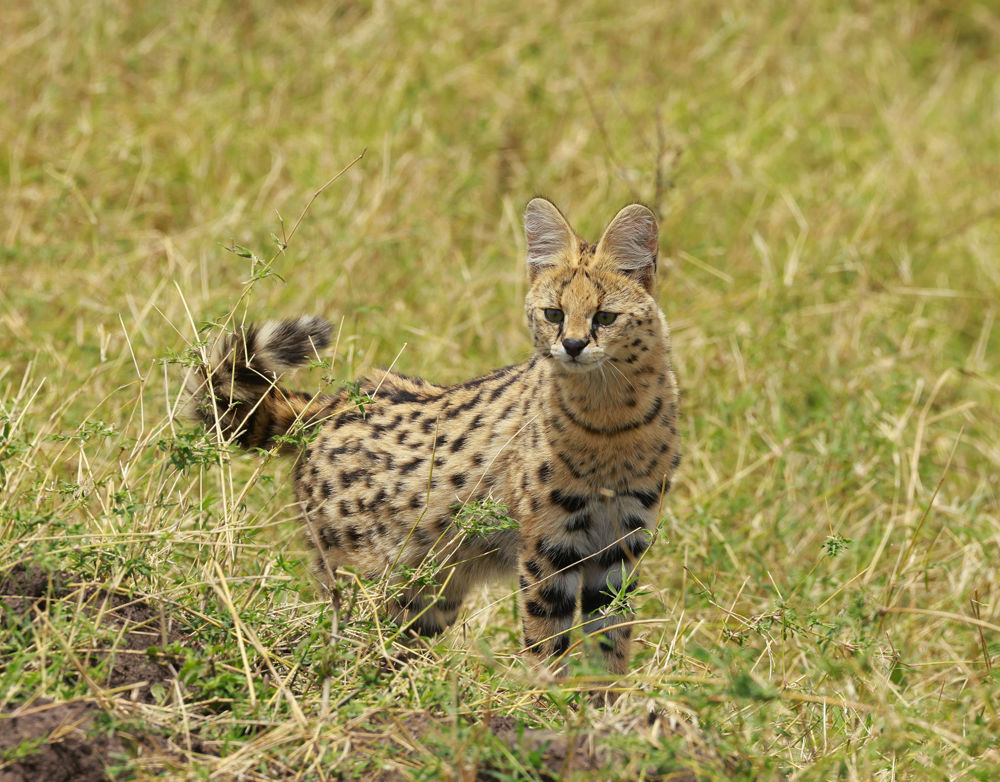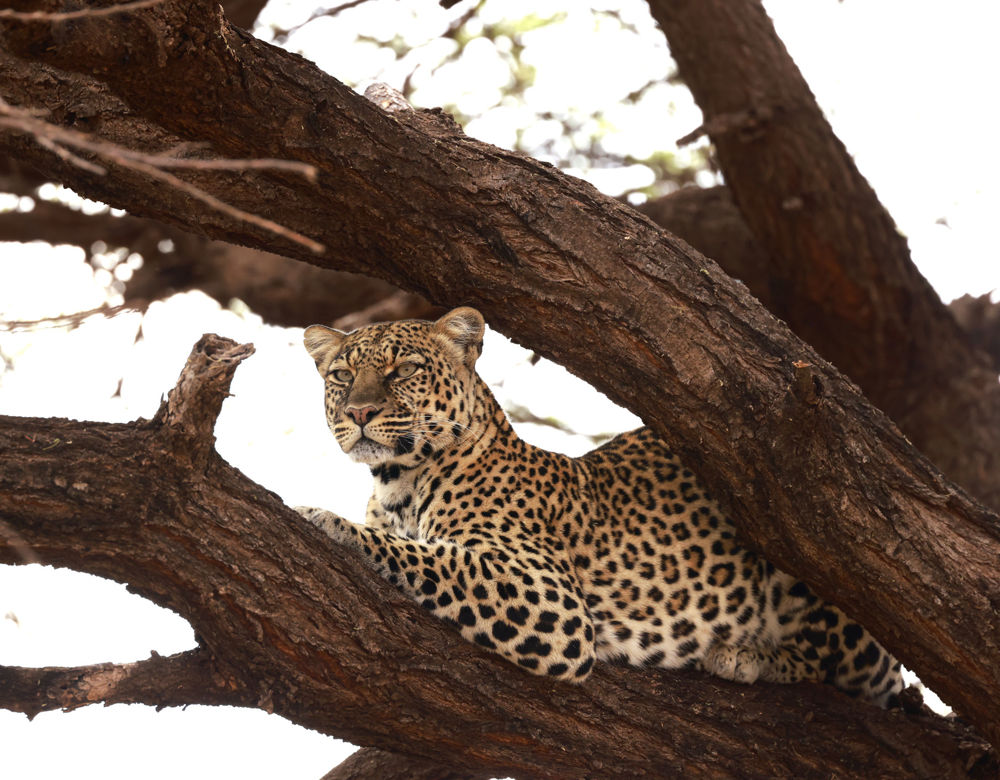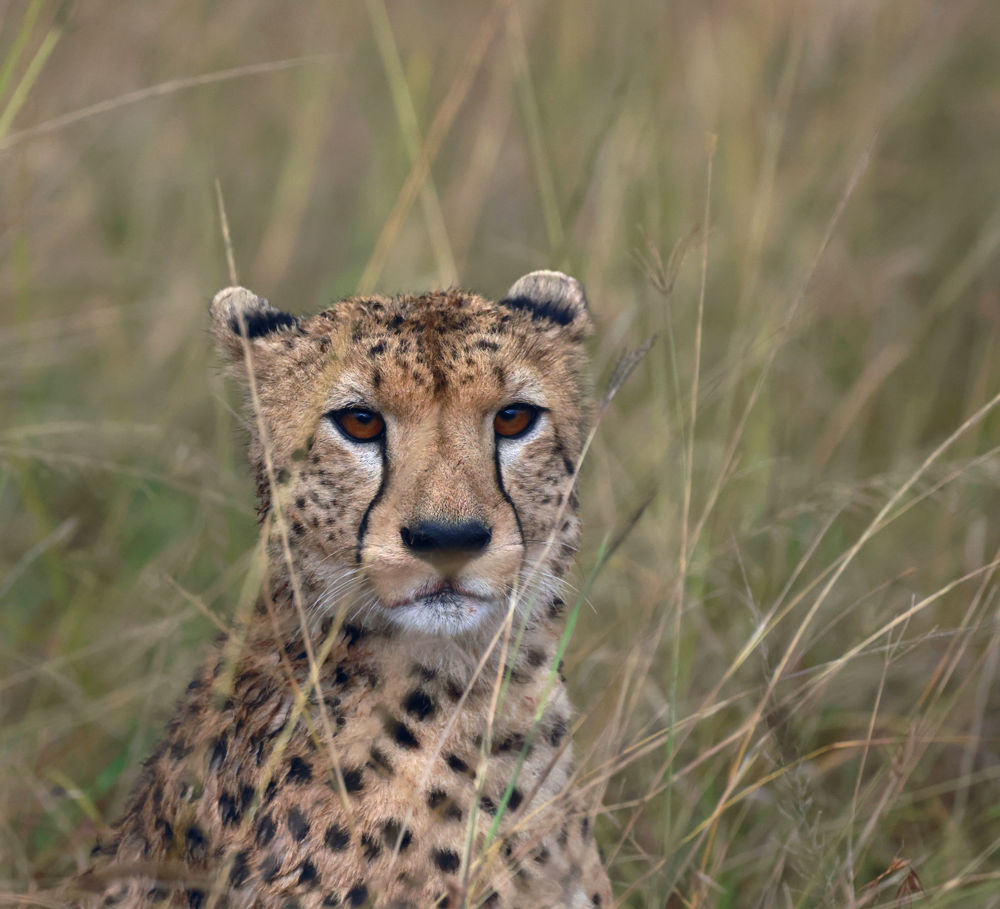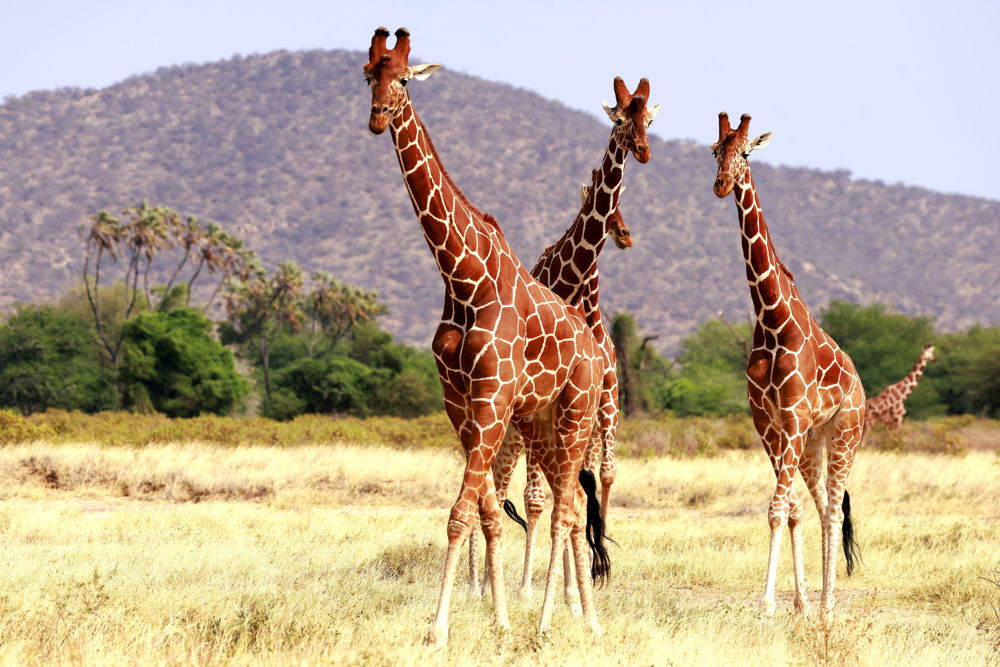Departure Date: August 7 - 25, 2025
Compiled By: Andrew Whittaker
Trip Leaders: Andrew Whittaker, Local Leader
Toll Free: 800.328.8368
Phone: 512.328.5221
Magical Kenya: Exotic Birds & Big Game Galore! 8/7/2025-8/25/2025

Kenya, the shining jewel in East Africa’s wildlife crown, produced an awesome birding and mammal bonanza for this great tour group. From the very first day, the vast savannas and superb national parks were a dream come true, and we ultimately saw over 400 bird species and a mega 53 species of mammal, including long studies of all the big cats. WOW! And the Masai Mara Wildebeest and Zebra migration was as mesmerizing as ever.
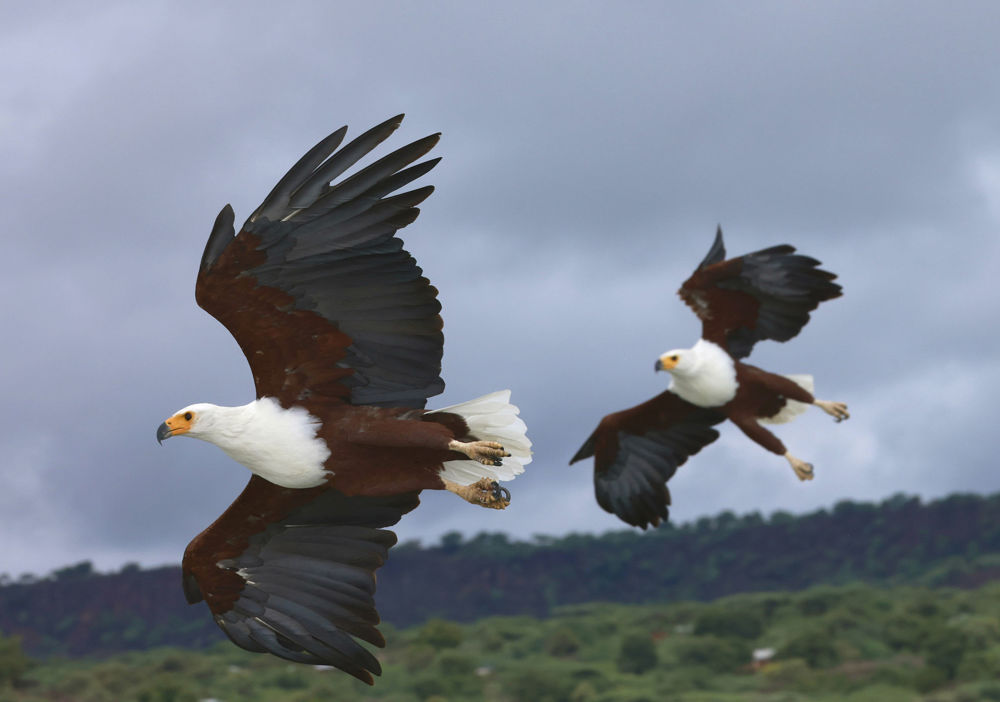
Pair of African Fish-Eagles swooping for fish on our Lake Baringo boat trip. Photo © Andrew Whittaker
Kenya’s great infrastructure, safe travel, and super-friendly people complement an amazing diversity of habitats, from plains and rolling hills, lakes and rocky cliffs, lush rainforests, and palm-bordered rivers to the stark acacia brush of Samburu. This range of landscapes hosts such exciting African families as ostriches, Hamerkops, Secretarybirds, guineafowl, turacos, oxpeckers, mousebirds, woodhoopoes, bushshrikes, and whydahs and widowbirds, putting Kenya high on the “must-visit” list, whether you are new to African birding or have visited many times before.
We began with an exciting game drive in Nairobi National Park, stronghold of the endangered White Rhino. Conditions were drier than normal, but along with the rhinos, we marveled at our first Masai Giraffe, Common Zebra, Hippo, Eland, Warthog, African Buffalo, Impala, Thomson’s Gazelle, Northern Bushbuck, and Black-backed Jackal. We also clocked an impressive 120 species of birds. Stately Ostriches were common on the grasslands alongside the recently split Sentinel Lark. Raptors included perched Gabar Goshawk, Augur Buzzard, and Long-crested Eagle. Black-winged Kites and Long-tailed Fiscals were abundant, while Little Bee-eater and Pangani Longclaw added color. We had great studies of Black Crake, Water and Spotted thicknees, Crowned and Blacksmith lapwings, Three-banded Plover, African Spoonbill, African Darter, African Fish-Eagle, and Malachite and Pied kingfishers. Scrub held Ruppell’s Robin-Chat, Scarlet-chested Sunbird, Striped Kingfisher, Sulphur-breasted Bushshrike, White-bellied Go-away-bird, and the stunning Red-cheeked Cordonbleu and Purple Grenadier on the roadsides. I even managed a lifer myself when I called in five African Snipe. Sharp-eyed Lance located the day’s highlight, a Serval hunting in the tall grass.

African Snipe. Photo © Andrew Whittaker
A rich marsh en route to the famous Masai Mara rewarded us with the odd White-backed Duck and African Swamphen. At the Mara, we experienced first-hand the breathtaking migration of immense herds of Wildebeest and Zebra; this year we were lucky enough to observe some river crossings, too. This abundance always attracts predators, including Lions, Leopards, elegant Cheetahs, and clans of Laughing Hyenas. Unforgettable were mega-close encounters with Lions and Cheetahs at kills—and simply amazing were two more hunting Servals and a mating pair of Lions!
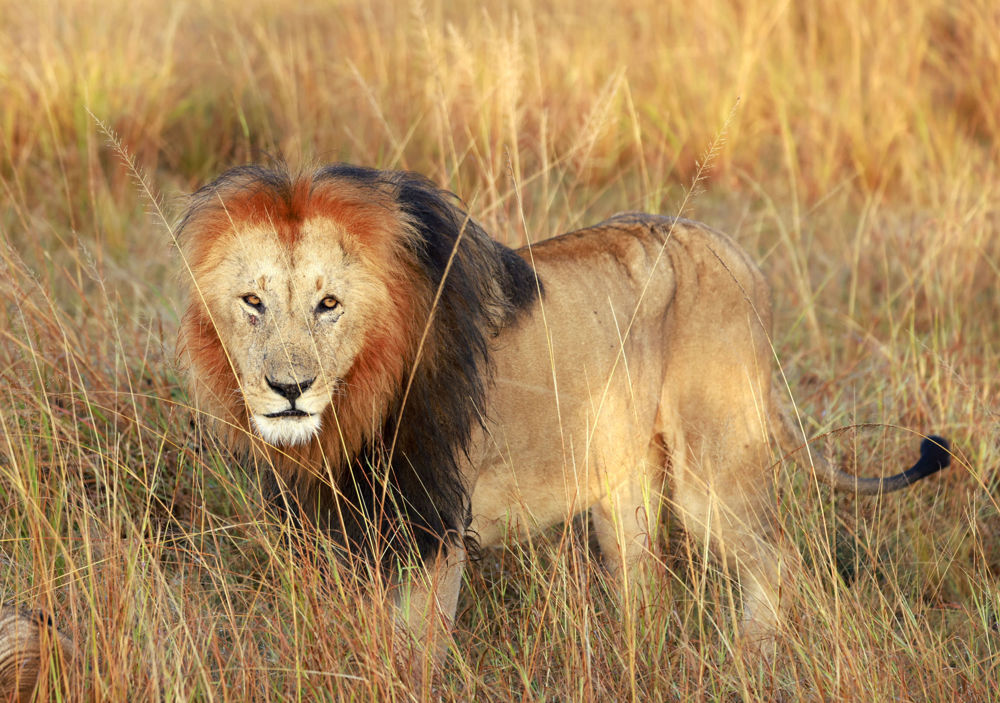
Impressive alpha male Lion “Black and Chestnut” © Andrew Whittaker
Our safari drives rewarded us with spectacular viewing of immense herds, from elephants, many with young, to sleek Cheetahs stalking gazelles. We had an enthralling half hour with a pride of Lions right next to us at a zebra kill. Other big mammal species included Spotted Hyena and Topi, which love standing on termite mounds to survey for predators. We also enjoyed Bohor Reedbuck, Defassa Waterbuck, Grant’s Gazelle, Banded Mongoose, and impressive groups of Olive Baboons.
Birding at our lodge was just as productive, with African Paradise-Flycatcher, White-headed and Spot-flanked barbets, Green-backed Woodpecker, Brown-throated Wattle-eye, Green-capped Eremomela, Mocking Cliff-Chat, White-browed Robin-Chat, Marico Sunbird, Violet-backed Starling, and Bare-faced Go-away-birds. A comfortable blind was the place to gain incredible insights into the behavior of a hundred Hippos—who will ever forget their bizarre repertoire of snorts and calls!
Birding in the paradise of the Mara was exceptional each day, and we tallied a superb array of shimmering sunbirds, bee-eaters, chats, barbets, bushshrikes, bishops, waxbills, and gaudy weavers. We shared noteworthy moments with hunting Secretarybird, African Hawk-Eagle, Lappet-faced Vulture, gaudy Saddle-billed Storks, Black and White-bellied bustards, Coqui Francolin, Harlequin Quail, Yellow-throated Sandgrouse, Wattled Lapwing, Southern Ground-Hornbill, unforgettable Lilac-breasted Rollers, Schalow’s and Ross’s turacos, Gray-headed and Woodland kingfishers, and Rosy-throated Longclaw.
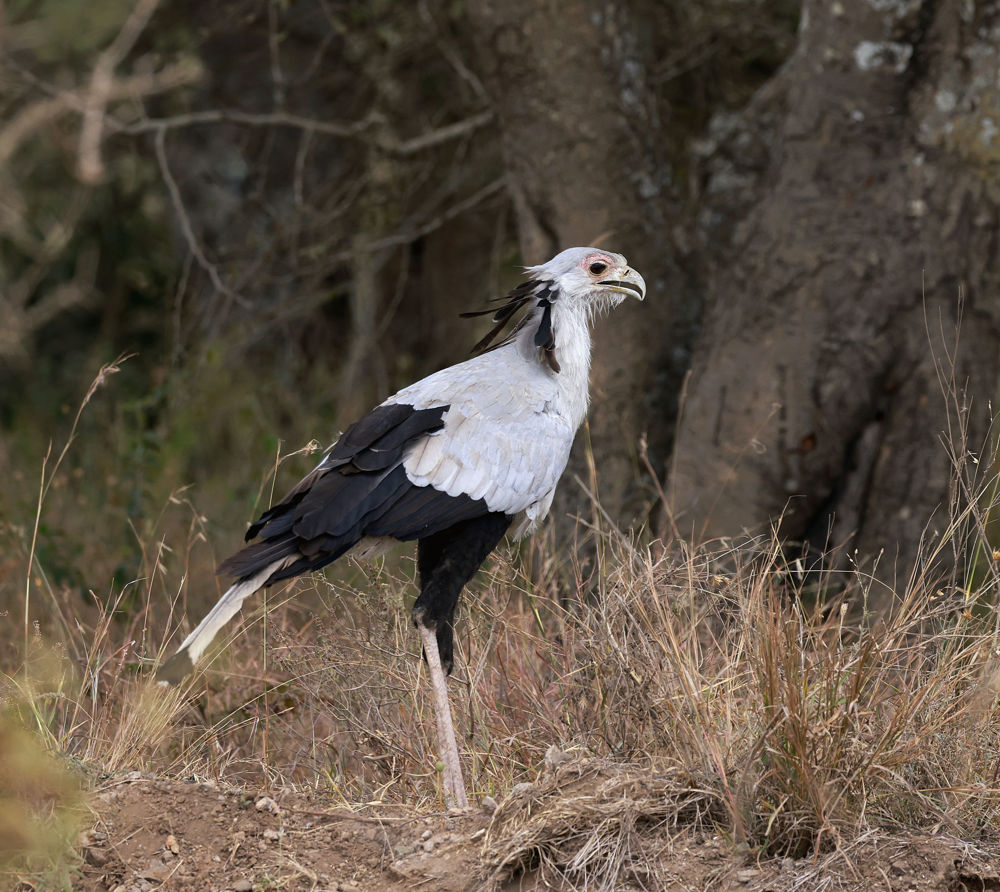
The iconic Secretarybird © Andrew Whittaker
We could not get enough of the world-class wildlife on show here in the Mara, a true birding paradise! But our next destination, the delightful lakes of the East African Rift, produced the Double-banded Courser, Southern Grosbeak-Canary, White-fronted Bee-eater, D’Arnaud’s Barbet, Hildebrandt’s Starling, and Silverbird. Over our first lunch at delightful Lion Hill Lodge, we kept binos at the ready as snazzy Greater Blue-eared Starlings and Vitelline Masked-Weavers visited a feeder. A Red-chested Cuckoo serenaded us as we checked in to our rooms to enjoy a short siesta, after which we began our exploration of the lakes and open woodlands, where we found several of the localized and strikingly beautiful Rothschild Giraffe, the youngsters even more prettily marked than their parents.
Lake Nakuru had hundreds of Great White and a few Pink-backed Pelicans, Little Grebes, Long-toed Lapwing, a pair of Greater Painted-Snipe, Ruff, Collared Pratincole, Kittlitz’s Plover, Curlew and Marsh sandpipers, African Openbill, Yellow-billed Stork, White-winged Tern, Gray-headed Gull, Yellow-billed Duck, Squacco Heron, and a few hundred Greater and Lesser flamingos. The plains held White Rhino, Grant’s Gazelle, Long-crested Eagles, Hildebrandt’s Spurfowl, and Eurasian Hoopoe, with the highlight beyond all doubt an incredible adult Martial Eagle.
We returned the next morning to soak in more of the incredible birdlife around this magical lake. The mammal highlight this time was exceptional views of the striking black-and-white Guereza Colobus. Top birds included Pied and Klaas’s cuckoos, Cinnamon-chested Bee-eater, White-bellied Tit, Abyssinian Wheatear, Long-tailed Widowbird, and stunning Amethyst Sunbirds—we quickly reached an exceptional total of 120 species!
After enjoying a nice meal, we arrived mid-afternoon at Lake Baringo. Our second-floor rooms overlooked the enchanting lake, and the lodge also offered a lovely panoramic lounge. Right outside our rooms was an active colony of Lesser Masked and Village weavers, as well as a magnificent pair of Gray Crowned-Cranes.

Gray Crowned-Crane © Andrew Whittaker
An afternoon on foot with our expert local guide produced a huge Grayish Eagle-Owl at roost. The birdy dry acacia also provided Hunter’s Sunbirds, African Cuckoo, Green Woodhoopoe, Jackson’s Hornbill, Black-throated Barbet, and a male Eastern Paradise Whydah with its wild-looking tail.
We awoke to heavy rain over the lake, which forced us to hold off on our boat trip. At breakfast, a couple of Bristle-crowned Starlings showed off in the rafters above us. Despite the late start to our boat trip, we found the lakeshore trees blessed with a few Olive Bee-eaters. Making our way along the lake edge and through reed-clogged channels, we had fabulous birding and photographic opportunities. Flashy Pied and Malachite kingfishers were numerous, and we also encountered a Giant Kingfisher, the enormous Goliath Heron, and several Squacco Herons. This year’s surprise highlights were a lovely male Little Bittern, which gave magnificent views, and a small flyby flock of Southern Pochards. We also witnessed the touching friendship between a local fisherman in his homemade balsa canoe and an extremely tame Hamerkop: he informed us that it was a female, and that she had been accompanying him every morning for four years to get a free fish breakfast!

Amazing trust between this fisherman (in his homemade Balsa canoe) and his friend the Hamerkop © Andrew Whittaker
The local African Fish-Eagle put on a fantastic show. Other interesting sightings were Purple Heron, Beautiful Sunbird, and colonies of Golden-backed Weavers, the males singing beneath their freshly built nests. African Darters and Long-tailed and Great (White-breasted) cormorants in lovely breeding plumage perched in the lakeside trees.
After our boat excursion, it was back into the acacia with our local birding expert. Carefully weaving through the thorny groves, we were shown incredibly camouflaged Slender-tailed Nightjars and my favorite owl, the cute Northern White-faced, followed by a pair of wondrous Three-banded Coursers, almost invisible as they roosted in the shade. A mega-bird indeed, and what magical scope views we enjoyed!

Superb Three-banded Courser © Andrew Whittaker
Following our siesta, we visited the spectacular escarpment for great scope studies of a pair of massive Verreaux’s Eagles and their prey, Black-necked Rock Hyrax. Other fun species included Lanner Falcon, Fan-tailed Raven, Hemprich’s Hornbill, Brubru, Northern Crombec, Red-and-yellow Barbets, Pygmy Batis, and Village Indigobird.
Next morning, we began our drive to the highlands, with a break at stunning Thomson’s Falls, where Silvery-cheeked Hornbills graced the wooded garden along with Slender-billed Starlings and a friendly Mountain Wagtail. Entering cooler Aberdare National Park, we encountered a lovely Red-throated Wryneck at the gate, and our first endemic Jackson’s Spurfowl gave exceptional views on the roadside. A walk on the lodge’s boardwalk was very productive, with fabulous looks at Northern Double-collared Sunbird, Kikuyu Mountain Greenbul, and the superb Hartlaub’s Turaco with its stunning crimson wings. Here, too, was my first-ever Red Duiker, and some lucky folks saw Slender Mongoose. After dinner, a pair of Common Genets gave great views at the lodge.

Fabulous Hartlaub’s Turaco © Andrew Whittaker
Due to exceptionally cold wet weather we only saw a few elephants arrived at the lick, however they offered fascinating close studies of how they use their tusks to dig up chunks of rock salt. The striking Bushbuck, Buffalo, and Giant Forest Hogs turned up, too. In the marsh were African Black Duck, Mosque Swallow, Montane Nightjar, Cape Robin-Chat, and Hunter’s Cisticola. Our exploration of the park’s extensive rainforest turned up a host of goodies, from Scaly Francolin to Lemon Dove, African Green-Pigeon, Black-fronted and Doherty’s bushshrikes, Chestnut-throated Apalis, Golden-winged Sunbird, and Yellow-bellied Waxbill.
Uncompromisingly rugged, Samburu National Park is known by the local nomadic tribe, the Gabba, as “the Plains of Darkness.” We arrived at our lovely lodge in the late afternoon, with fantastic views from our rooms out over the muddy river and stunning plains.
On magical safaris over the next two days, we enjoyed stately Beisa Oryx, the rare Grevy’s Zebra, and delicately marked Reticulated Giraffes, while some of our encounters with elephant families were almost too close! Cute Kirk’s Dikdiks hid in the brush while long-necked Gerenuk fed like ballerinas, delicately balancing themselves on their front legs. Indisputably one of the park’s top birds is the odd-looking Vulturine Guineafowl—wow, what vivid colors.
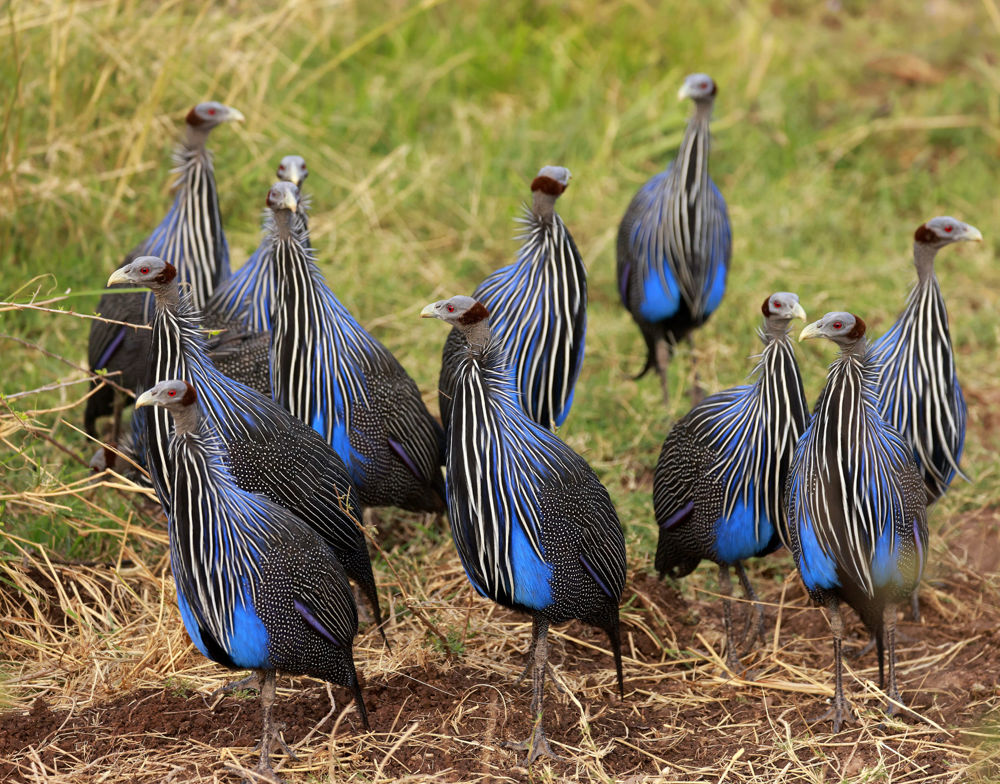
Wow! Highly sought-after Vulturine Guineafowl © Andrew Whittaker
And what a moment it was as we watched a young Martial Eagle try to capture Helmeted Guineafowl! Other avian delights included a bold male Somali Ostrich with a family, Buff-crested Bustards, Emerald-spotted Wood-Dove, Violet Woodhoopoe, Von der Decken’s Hornbill, Somali Courser, Rosy-patched Bushshrikes, Taita Fiscal, Cut-throat, Donaldson Smith’s Sparrow-Weaver, and sharp-looking Lichtenstein’s, Chestnut-bellied, and Black-faced sandgrouse. The top spot, however, has to be reserved for a splendid female Bateleur feeding close by.

Striking adult female Bateleur © Andrew Whittaker
At our birdy lodge, the tiny Pearl-spotted Owlet, the localized White-headed Mousebird, Rufous Chatterer, White-rumped Shrike, Spotted Mourning-Thrush, glistening Eastern Violet-backed Sunbirds, and comical Northern Red-billed Hornbills kept us happy. Notable mammals included Lesser Kudu, Common Waterbuck, Desert Warthog, and fantastic studies of a cute Lesser Galago (bushbaby) in the garden.
Finally we had to make our way back to Nairobi, with a stop at Cheges Camp for a very pleasant bit of birding on the lovely forested grounds and feeders, where we saw Ochre Bush Squirrels, African Golden Weaver, Red-billed Firefinch, and Red-cheeked Cordonbleu; the highlight here was a smart adult African Harrier-Hawk. We were back at our pleasant Nairobi hotel by mid-afternoon, with time to shower and pack before saying our goodbyes and catching homebound flights.
We had enjoyed a truly fabulous African trip together, with a large cross section of big game and exotic birds alike. Thank you all for being such a fun group to share so many breathtaking once-in-a-lifetime moments with. I am already looking forward to returning next summer to this exceptional and friendly country that has touched all our hearts. I hope you enjoy reading my report and that it brings back some wonderful memories. Hopefully we will cross paths again on one of my many exciting VENT tours worldwide.
Top seven birds and mammals selected by the group:
1: SECRETARYBIRD
3: SADDLE-BILLED STORK
4: AFRICAN FISH-EAGLE
5: LILAC-BREASTED ROLLER
6: MALACHITE KINGFISHER
7: VULTURINE GUINEAFOWL/WHITE-FRONTED BEE-EATER
1: LEOPARD
2: GIRAFFES
3: SERVAL
4: CHEETAH
5: LION
6: ELEPHANT
7: COMMON GENET
A complete list of the birds recorded on our tour can be found at: https://ebird.org/tripreport/
Description for the next departure of this tour.

